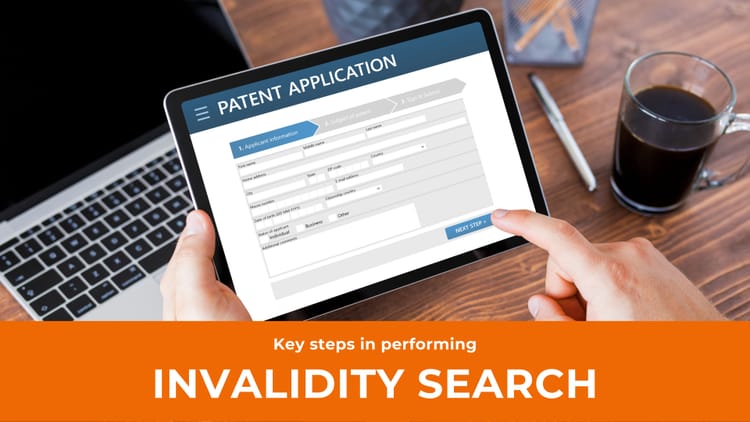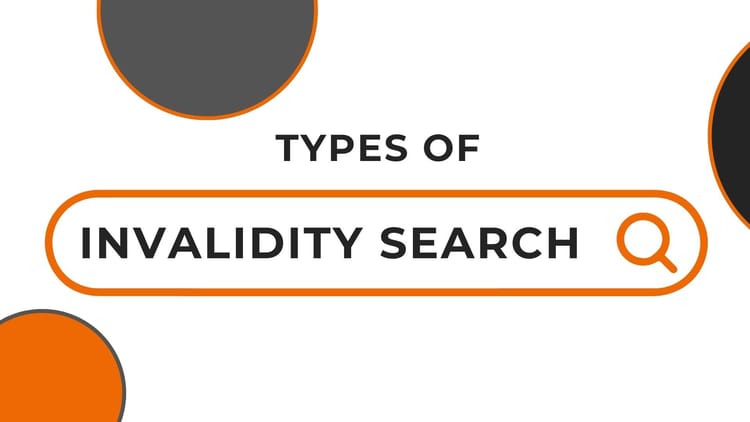The Anatomy of an Invalidity Search Report
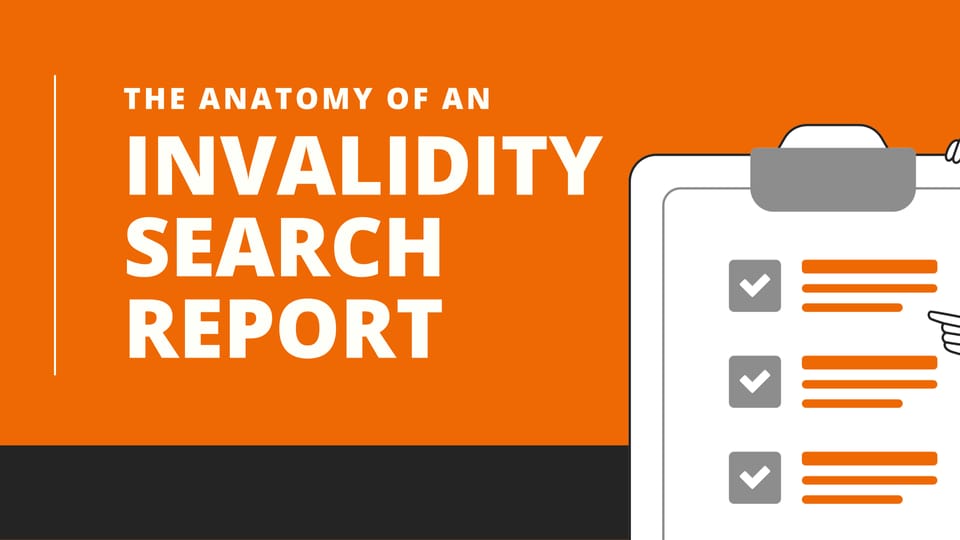
Introduction
In the intricate labyrinth of patent law, invalidity search reports serve as both the map and the compass. These invaluable documents dissect patents down to their elemental parts, scrutinizing every claim and counterclaim to determine the validity of the intellectual property in question. When the stakes are as high as they are in patent litigation or business transactions, an invalidity search report isn't just a luxury—it's a necessity.
In the ever-evolving sphere of intellectual property, these reports have carved out a crucial role for themselves. They often serve as the bedrock upon which legal arguments and business decisions are built. Whether you're a corporate titan wrestling with the complexities of a multi-million-dollar merger or an independent inventor peering into the labyrinth of patent law, understanding the nuances of an invalidity search report can be your ace in the hole.
So, what should you expect to glean from this blog? We'll demystify an invalidity search report's structure, elements, and significance. By the time you reach the end, you'll comprehend what goes into these reports and why they can be the pivotal factor in a patent-related venture.
What Constitutes an Invalidity Search Report?
An invalidity search report is like a well-crafted mystery novel. It has its characters (the patents in question), plot twists (legal challenges), and, most importantly, a resolution (findings of validity or invalidity). However, unlike a mystery novel, there's no room for interpretation. The report is a structured document delineated into various sections, each serving a specific purpose.
Structure of the Report
Executive Summary: This is the report's trailer. It offers an overview of the objectives, scope, and key findings. Usually, decision-makers needing more time to sift through the entire report would focus on this section.
Methodology: This is where the report lays out the approach taken during the search. It'll cover the databases accessed, the criteria for selection, and any limitations faced during the search. It's akin to the 'behind-the-scenes' footage that adds credibility to the final product.
List of References: An exhaustive list of all the documents, patents, and publications referred to during the search. This section is the bedrock upon which the report stands. Every claim made in the report is substantiated by a reference listed here.
Claim Charts: This section dives deep into the patent claims in question. It matches each claim against prior art references, effectively laying out the argument for or against the patent's validity.
Legal Analysis: The meat of the report, where the search findings are evaluated in the context of existing patent law. This section will often contain insights into how the prior art impacts the patent's validity and what legal remedies might be available.
Conclusions and Recommendations: The report comes full circle in this section, summarizing the findings and suggesting the next steps. It’s the author’s final words before sending the reader on their way.
Each section is like a cog in a well-oiled machine, meticulously designed to offer comprehensive insights. Whether you're an attorney looking to build a case or a business leader considering a patent acquisition, understanding the structure and contents of an invalidity search report is crucial. It informs every journey step, from initial consideration to final decision-making.
Why Is It Important?
Consider an invalidity search report as the Swiss Army knife of patent law; it's multi-functional and indispensable in various scenarios. Here's how:
Role in Patent Litigation
Decision-making Blueprint: In a courtroom drama, a good script is paramount; the same holds for patent litigation. An invalidity search report serves as a script, guiding attorneys on how to proceed with their arguments.
Risk Mitigation: You need to know its depth to dive into a pool, do you? Similarly, these reports can help assess the risk of challenging a patent’s validity. This helps attorneys advise their clients on whether it's worth pursuing litigation.
Patent Portfolio Management
Strategic Alignment: Companies invest heavily in R&D and patents. An invalidity search report can help portfolio managers assess the strength of patents in their portfolio, ensuring alignment with business strategy.
Acquisition & Licensing: Knowing what you're diving into is essential before considering buying or licensing a patent. These reports act as a litmus test for the quality of patents you intend to acquire or license.
Valuation of Intellectual Property
Quantifiable Insights: Who says you can't put a price on ideas? When it comes to intellectual property, valuations are a complex affair. Invalidity search reports add a layer of data-driven insights that help assign a monetary value to a patent.
Investor Relations: Transparency and credibility are the cornerstones of any investment. When you have a robust invalidity search report, it becomes easier to gain the trust of stakeholders and potential investors.
The beauty of an invalidity search report is its versatility. It's a legal document and a comprehensive guide to strategic planning, risk assessment, and financial decision-making. Its multi-dimensional relevance makes it a linchpin in the world of intellectual property, helping everyone from litigators to business leaders make informed decisions.
The Process Behind Creating One
Creating an invalidity search report isn't a walk in the park; it's more like a trek through a mountain range—requiring preparation, skill, and a dash of tenacity. Here's a breakdown of how this comprehensive document is crafted:
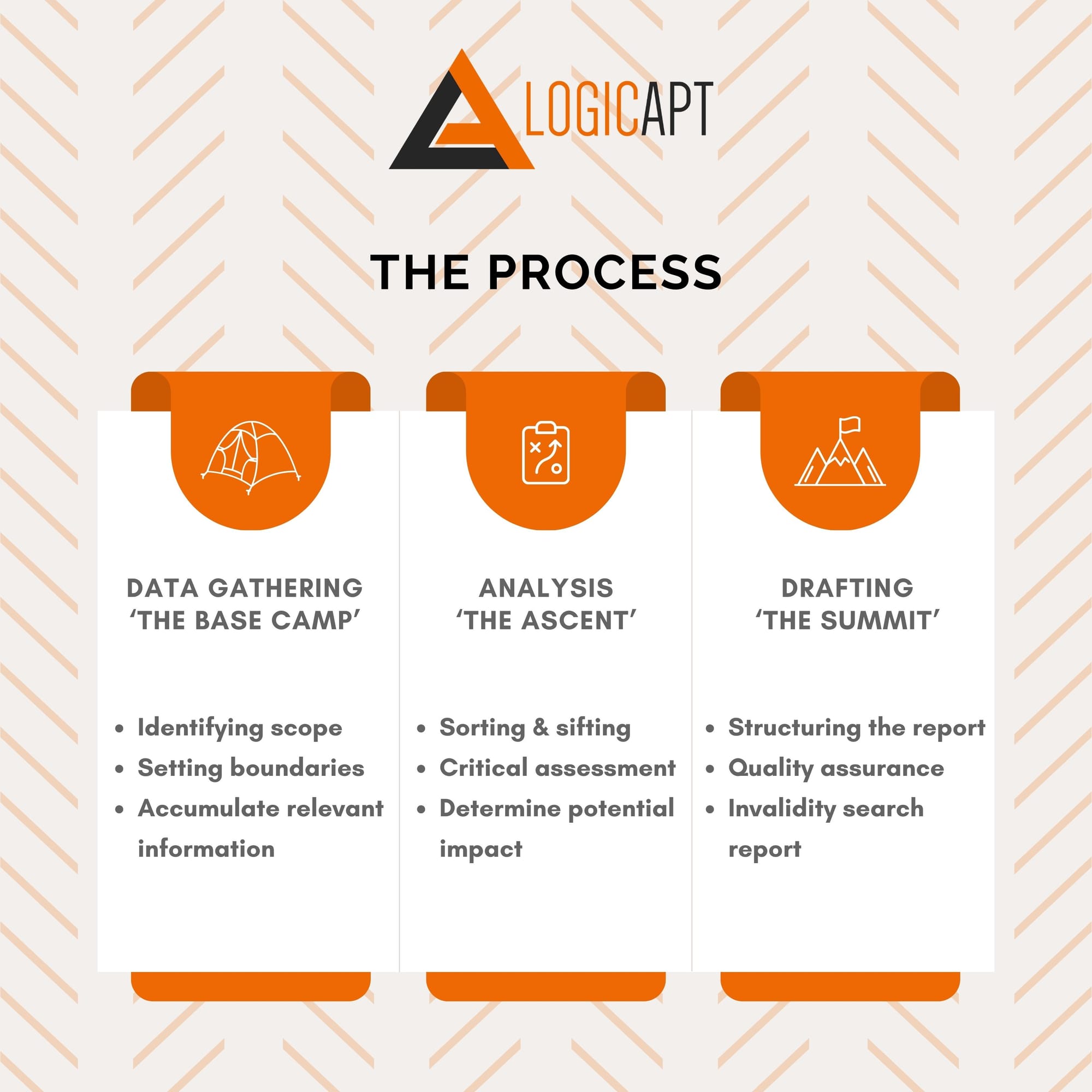
Data Gathering: The Base Camp
Identifying Scope: Before embarking on the data-gathering expedition, setting the boundaries is crucial. What patents are under investigation? What is the technology domain? These questions define the scope and set the direction for the search. What are the patent claims under consideration? How is the other party interpreting the claims?
Database Dive: Equipped with the scope, search experts plunge into various patent databases, scholarly articles, and other publications. The goal is to accumulate relevant information—be it a patent application from the '90s or a cutting-edge research paper.
Analysis: The Ascent
Sorting and Sifting: Once all the data is in place, it's time to roll up the sleeves and start sorting. It involves categorizing the gathered data by relevance, date, technology domain, etc. Sometimes, this is an interactive and parallelized process wherein data collection and analysis happen hand-in-hand.
Critical Assessment: The heart of the report lies in the analysis. This is where experts critically assess each piece of information to determine its potential impact on the patent’s validity. They ask questions like, "Does this prior art invalidate any claims?" or "Is this evidence strong enough?"
Drafting: The Summit
Structuring the Report: The team has a treasure trove of analyzed data. The next step is to structure it in a coherent, easy-to-follow format. This often includes an executive summary, detailed findings, recommendations, and appendices.
Quality Assurance: Before the report sees the light of day, it undergoes rigorous quality checks. This ensures that every argument is substantiated, every claim is backed by evidence, and every loophole is sealed.
At the end of this journey, an invalidity search report emerges. This meticulously crafted document can influence legal outcomes, shape business strategies, and sometimes even alter the course of technological innovation.
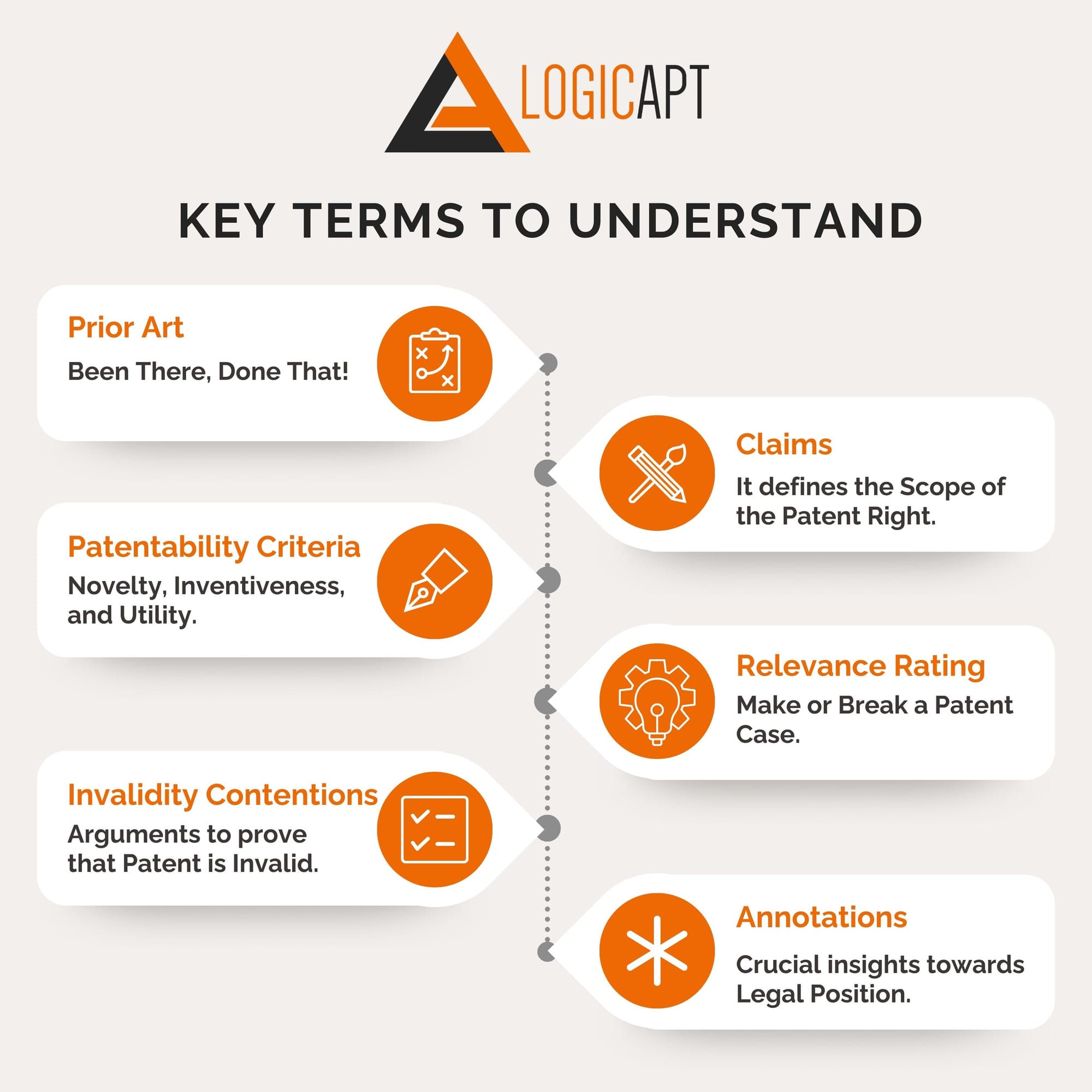
Key Terms to Understand
In the mystical world of invalidity search reports, jargon can often feel like a foreign language—both exotic and perplexing. Let's decode some of these often-used but rarely-explained terms so that you don't get lost in translation:
Prior Art: Think of this as the "been there, done that" of the patent world. It refers to any evidence that your invention was publicly known before the filing date. This is the bane of any patent application and the crown jewel of an invalidity search report.
Claims: These aren't your run-of-the-mill "I swear I didn’t eat the last cookie" claims. In patent terminology, claims define the scope of the patent right. They're the borders of your intellectual property country, if you will.
Patentability Criteria: This is the Holy Trinity of patent validity: Novelty, Inventiveness (or Non-obviousness), and Utility. If an invention meets these criteria, it's like the patent version of "The Chosen One."
Relevance Rating: In the report, you'll often find pieces of prior art rated for their relevance to the patent. It's like Yelp, but for legal elements that can make or break a patent case.
Invalidity Contentions: These are the arguments or positions taken to prove that a patent is invalid. Think of them as the prosecutor's points in a court trial to knock down a patent's validity.
Annotations: These are not just scribbles on the margin. Annotations offer crucial insights and explanations for pieces of evidence or legal positions. They serve as the decoder ring to the complex world of patent law.
By understanding these terms, you're not just skimming the surface; you're diving into the deep end of the invalidity search report. So the next time you come across one, you'll navigate it like a pro, free from jargon.
Common Formats and Templates
Formats—the suit and tie of an invalidity search report. As you wouldn't wear flip-flops to a board meeting, choosing the correct design for your report is crucial for making the right impression. But it's not just about looking good; it's about efficiency and clarity, too.
PDF Reports:
The most formal attire for your data, PDFs are ubiquitous and compatible across multiple platforms. They're easy to share and protect with security features. However, the downside is that they need to be more easily editable.
Pros: Universally accessible and secure.
Cons: Static, not interactive.
Word Documents:
Think of this as business casual. Word docs are easily editable, which is great for collaborative environments. However, they lack the security features of a PDF.
Pros: Editable, easily converted to other formats.
Cons: Security concerns.
Spreadsheets:
This is the casual Friday of report formats. Spreadsheets are fantastic for sorting data, making them excellent tools for internal reviews.
Pros: Highly interactive, excellent for data sorting.
Cons: Can be cumbersome for extensive reports, less formal.
Web-Based Reports:
Imagine this as your tailored, tech-savvy suit. Web-based reports are interactive and can be updated in real-time. However, they require internet access, which might only sometimes be ideal.
Pros: Real-time updates, interactive.
Cons: Requires internet, not universally accessible.
Industry Templates:
There are also industry-standard templates designed explicitly for invalidity search reports. These are your three-piece suits—elegant, standardized, and trustworthy.
Pros: Standardized, efficient.
Cons: It may need more flexibility for unique cases.
Choosing the correct format is like picking the right wardrobe for the occasion—it sets the tone and functionality for your interaction with the data. So, when in doubt, always consider your audience and purpose before zipping up that report!
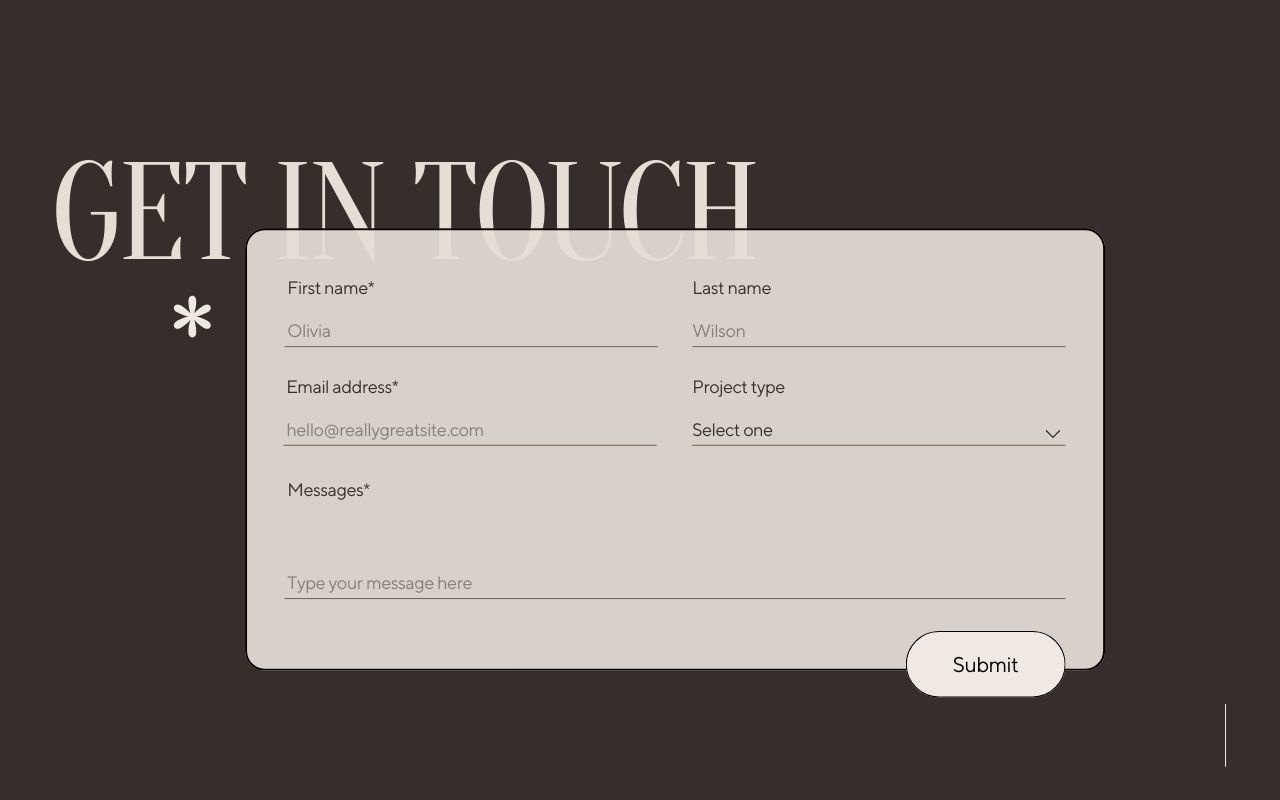
Analyzing a Sample Report
Roll up those sleeves because we're diving into the nitty-gritty—a sample invalidity search report. Consider this the "CSI: Patent Law" episode, where we dissect a report to understand its anatomy, minus the dramatic music and slow-motion camera effects. After the lecture, this is your hands-on lab session, a chance to see theory in action.
Header Information
First, our sample report starts with the header information, which is the "who, what, and when" of the report. It details the patent in question, the entity requesting the search, and the date of the report. This section is your elevator pitch—it tells the reader what to expect and why they should care.
Executive Summary
Moving on, we have the Executive Summary. Think of this as the trailer for your report—compelling, informative, and brief. It highlights the critical findings and the potential impact on the patent. While trailers can sometimes give away too much, a well-crafted executive summary gives just enough to whet the appetite.
This section should provide the following key details about the patent:
- Patent number, filing date, date of issue, and title.
- Names of all inventors listed.
- Current owner/assignee.
- Priority claims to earlier applications (if any).
- Summary of the disclosed invention in 2-3 paragraphs covering the technical field and purpose of the invention.
- Brief description of the drawings (if present) covering the central figures.
- Claims construed by the Court (if a claim construction order has been issued).
- All independent claims are charted out separately and verbatim.
Methodology
Next, the Methodology section is where we lift the curtain to reveal the wizard. This section outlines the databases searched, search strings used, and any filters applied. Essentially, it's the recipe for how the information was cooked up.
This section should describe:
- Databases searched - Include all patent and non-patent literature databases searched, such as Google Patents, commercial patent databases (Orbit, Derwent, STN, etc.), IEEE Xplore, ACM Digital Library, etc.
- Search strings used - Provide examples of key search strings such as element names, technical terminology, synonyms, inventors, assignees, etc.
- Classes and subclasses searched - Identify all USPC/CPC classifications searched based on categories of the patent itself.
- Non-patent literature sources - Besides databases, scientific journals, trade journals, conferences, textbooks, and product manuals are searched.
- Targeted searches - Describe any focused searches for particularly pertinent limitations or technologies.
- Known prior art - List any references already known to the inventors/applicants uncovered during prosecution.
- Related foreign/PCT apps - Identify any corresponding foreign counterparts and PCT applications checked for applicable prior art.
- Inventor/expert interviews - Note any discussions with inventors or technical experts to identify possible relevant prior art areas to search.
- Search terms/synonyms - Provide examples of specialized keywords, alternate spellings, and synonyms used.
Findings and Analysis
Ah, the meat and potatoes of our report—the Findings and Analysis. This section is jam-packed with references, comparative tables, and expert commentary. Each prior art listed is analyzed concerning the patent's claims under scrutiny. If the Executive Summary is the trailer, this section is the feature-length film.
Summary of Prior Art References
The Summary of Prior Art References section provides an annotated list of the closest prior art references uncovered during the invalidity search.
For each significant reference, provide concise identifying information and a short 1-2 sentence summary of the disclosure. Focus on the closest approximately 10-20 references that will be relied upon for your invalidity positions.
Organize the references thematically by standard features or limitations they share to tell a compelling story of the prior art landscape. Group references that, for example, focus on similar aspects of the claimed invention or originate from the same field/companies.
Anticipation Analysis
The Anticipation Analysis section contains detailed arguments demonstrating that one or more claims lack novelty under 35 U.S.C. 102 given specific references.
Structure each anticipation argument as follows:
- Identity of the reference relied upon, including complete bibliographic information and date qualifying it as prior art.
- Short 1-2 paragraph summary of the disclosure of the reference.
- Mapping each element/limitation of the claim to specific text, figures, or other disclosures from the reference that teach that particular claim element/limitation.
- Explanation of how the mapped disclosures in the reference explicitly and inherently anticipate the claimed invention.
- Analysis of any pertinent case law regarding the standard for anticipation and how the reference fits that standard.
- Charts mapping each claim element/limitation to the portions of the reference may help illustrate anticipation visually.
- Address any alleged shortcomings of the reference and explain why anticipation is still met.
Craft separate sections for each primary anticipation reference argument. Focus on your 1-2 strongest anticipation arguments.
Obviousness Analysis
The Obviousness Analysis section presents arguments demonstrating that one or more claims are invalid, as evident under 35 U.S.C. 103, given identified combinations of prior art references.
For each obviousness combination, structure the argument as follows:
- Identity of the primary reference relied upon, including complete bibliographic citation and a 1-2 paragraph summary of the disclosure
- Identity of secondary references relied upon, with bibliographic citations and short 1-2 sentence summaries of their disclosures
- The rationale for combining the primary and secondary concerns – i.e., motivation to connect, such as:
- Combining prior art elements according to known methods to yield predictable results
- Simple substitution of one available element for another to obtain predictable results
- Use of a general technique to improve similar devices/methods in the same way
- Applying a known approach to a known device/method ready for improvement
- “Obvious to try” by choosing from a finite number of identified, predictable solutions with reasonable expectation of success
- Mapping of each claim element/limitation to text, figures, or other disclosures from the primary and secondary references that teach that particular claim element/limitation
- Explanation of why the combination of references teaches the claimed invention as a whole
- Analysis of any objective indicia/evidence of non-obviousness that may favor patentability
- Charts illustrating how the combination of references teaches the claim may be helpful for more complex arguments.
Consider structuring obviousness combinations as follows for readability:
- Primary Ref given Secondary Ref A
- Primary Ref given Secondary Refs A and B
- Primary Ref was given Secondary Ref A, and Secondary Ref B was further given.
Focus on your most potent 1-2 combinations for conciseness. Address any potential weaknesses in the combinations and explain why obviousness is still met.
Secondary Considerations of Non-Obviousness
The section analyzes objective evidence that may weigh against a finding of obviousness.
If applicable, address considerations such as:
- Commercial success of the claimed invention
- Long felt need in the industry for the claimed invention
- Failure of others to arrive at the claimed invention
- Unexpected results achieved by the claimed invention
- Industry praise/recognition of the claimed invention
- Licensing/copying of the claimed invention by competitors
For each consideration, discuss the nexus between the evidence and the novel features of the claimed invention. Argue that any nexus is weak or non-existent to minimize the impact on invalidity.
Conclusion and Recommendations
The Conclusion section summarizes the key invalidity positions presented based on anticipation and obviousness given the prior art uncovered.
Succinctly explain how the asserted claims are invalid under 35 U.S.C. 102 and 35 U.S.C. 103 in light of the prior art references and arguments detailed in the report. The conclusion serves as the final takeaway of the invalidity arguments.

Pitfalls to Avoid
It's all fun and games until someone messes up an invalidity search report. We've all heard horror stories—perhaps whispered in hushed tones across the dimly lit rooms of patent law firms—about blunders that turned a report into a convoluted mess. Or, even worse, rendered it useless. Buckle up because we're about to enter the "What Not To Do" territory.
Inadequate Methodology Description
One of the common missteps is skipping over the methodology section. A well-defined methodology is the backbone of your report and its credibility card. The lack of detail here can raise eyebrows and questions about the report's validity. Remember, ambiguity is not your friend when the stakes are as high as invalidating a patent.
Overloading the Executive Summary
Picture this: an executive summary that reads like a novella. Long-winded summaries are a double-edged sword; they either overwhelm the reader or get skipped altogether. Stick to the highlights and let the rest of the report do the heavy lifting.
Misinterpretation of Findings
Another pitfall to avoid is the misinterpretation or oversimplification of findings. The analysis should be thorough, accurate, and unbiased. Misrepresenting data can discredit the report and lead to erroneous conclusions that could affect legal judgments.
Ignoring the Devil in the Details
Last but not least, ignoring minor details can also be a grievous error. Think of filing dates, patent families, or citations—all these seemingly trivial elements can greatly impact your report's efficacy. The devil is truly in the details, so ignore them at your peril.
Additional Tips for a Compelling Invalidity Search Report
Here are some additional tips for drafting an airtight invalidity search report:
- Use consistent naming conventions/terminology for claim elements/limitations
- Focus report around your 1-2 strongest anticipation references and obviousness combinations
- Break out each claim limitation on separate lines for intricate multi-part claims
- Liberal use of figures/diagrams from references to illustrate invalidity arguments
- Use exact quotes from relevant passages of references rather than paraphrasing
- Discuss any potential shortcomings of references and arguments in your favor
- Be aware of any missing elements/limitations when mapping to references
- Summarize prosecution history and relevant litigation/IPR regarding validity
- Proofread thoroughly - double-check citations, typos, inconsistent terminology, etc.
- Use bullet points, numbered lists, and headings liberally for readability
- Include a table of contents for quick navigation of lengthy reports
The Future of Invalidity Search Reports
The future! A mysterious realm where invalidity search reports could be compiled by AI bots and interpreted by quantum computers. But let's not get ahead of ourselves—or should we? Let's dive into what the future holds for these all-important tomes of patent wisdom.
Artificial Intelligence and Machine Learning
The first candidate stepping into the spotlight is AI. Artificial Intelligence and its trusty sidekick, Machine Learning, are revolutionizing data analysis. Traditional search methods might soon seem as outdated as a flip phone. With AI's ability to sift through mountains of data at lightning speed, the accuracy and efficiency of invalidity search reports could see a dramatic uplift. The technology can identify patterns and correlations that even the most experienced human eyes might miss. In the near term, however, it would be an AI-first approach, wherein human experts take over the initial grunt work fed by an AI-driven engine instead of starting from scratch.
Blockchain Technology
Another game-changer on the horizon is Blockchain technology. Known for its unalterable records, Blockchain could provide a much-needed layer of authentication and credibility to the reports. Imagine a world where the provenance of every piece of prior art could be traced back with unimpeachable accuracy. Now, that's a future worth looking forward to!
Natural Language Processing (NLP)
Language barriers are one of the bases of comprehensive invalidity searches. Enter Natural Language Processing (NLP). This technology has the potential to break down linguistic barriers, making it easier to include non-English patents and literature in the search, thus enhancing the report's scope and reliability. The caveat applies - a word-to-word translation would render the patent meaningless. Context and depth are the keys.
One thing's clear: technology is not just an add-on; it's becoming the backbone of how invalidity search reports are compiled and analyzed. So, for anyone deeply involved in the world of patents, keeping an eye on these tech trends is not just advisable—it's essential.
Conclusion
As we draw the curtains on this in-depth exploration of invalidity search reports, let's pause for a final standing ovation—or should we say, a standing "ovation of understanding." We've traversed the lay of the land, from what constitutes these reports to the geeky yet enthralling details of AI and Blockchain that may revolutionize how these reports are made.
Understanding the anatomy of an invalidity search report isn't just for the patent-savvy elite; it's a must for anyone who wants to navigate the labyrinthine world of intellectual property law with finesse.
The journey to mastering the realm of patents is much like cooking a gourmet meal—each ingredient, or in this case, each section of the report, is vital. Miss one, and you've got a recipe for disaster. That's why it's not just about "having a report" but understanding each byte and bit of it, especially in an era where technology is rewriting the rulebook.
So, as you venture into your patent endeavors, consider the value of a well-prepared invalidity search report. If the nitty-gritty of data analysis, legal frameworks, and evolving technologies seem daunting, professional help is not just a click but a necessity away.

References & Additional Resources
For those keen on diving deeper into the intricacies of invalidity search reports, the following resources offer valuable insights:
"Patent Law Essentials: A Concise Guide" by Alan L. Durham - A comprehensive guide to understanding the basics of patent law, including the importance of invalidity searches.
"Patents and How to Get One: A Practical Handbook" by U.S. Department of Commerce - This governmental resource provides a foundational understanding of the patent process.
"Introduction to Intellectual Property: Theory and Practice" by World Intellectual Property Organization (WIPO) - A publication focusing on global intellectual property laws, including chapters on patent invalidity.
Journal of Intellectual Property Law & Practice - A peer-reviewed journal offering articles, case law, and news in IP law, including the nuances of patent invalidity.
United States Patent and Trademark Office (USPTO) Database - Not a reading material per se, but an invaluable resource for conducting any patent-related search, including invalidity searches.

